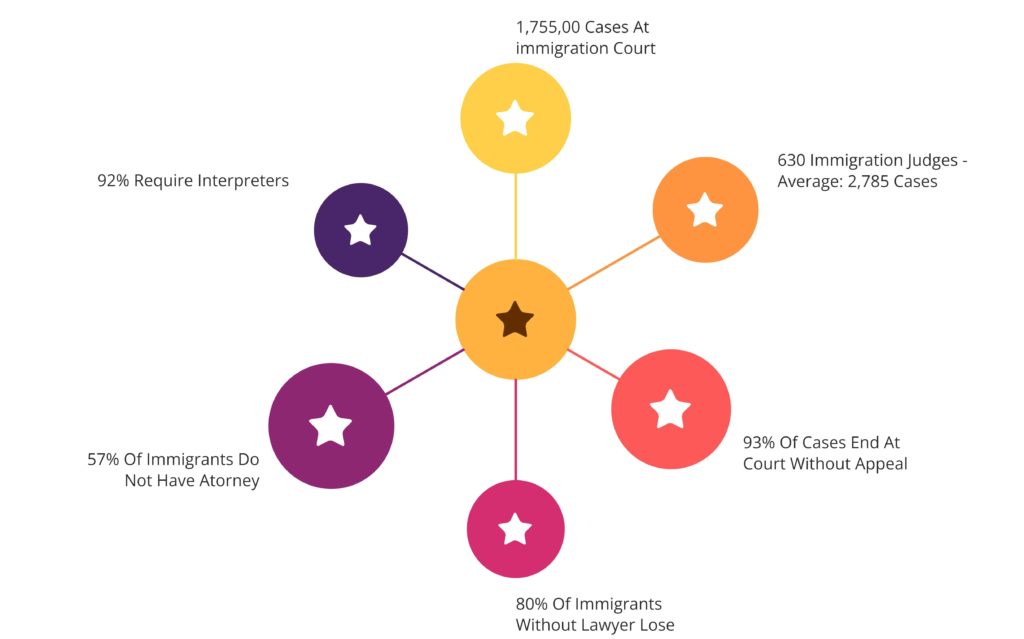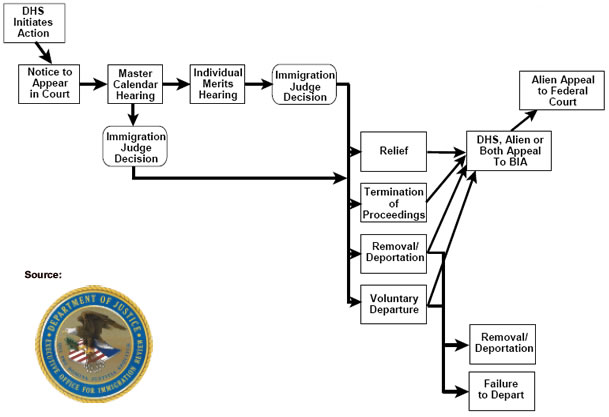
Do you have a removal hearing at immigration court coming up?
Winning your case against deportation will not be easy. There are many factors which makes success difficult to achieve at immigration court.
Let’s start at the beginning.
Table Of Contents
- What Is Immigration Court?
- What Is Deportation?
- Removal vs Deportation
- How The Overload Of Removal Hearings Impacts Your Chance For Success
- What Is Deportation Defense?
- What Are Defenses To Deportation?
- Immigration Court Proceedings Flow Chart

What Is Immigration Court?
The immigration court is an administrative court. At immigration court, judges conduct deportation and removal proceedings.
The immigration court’s official name is the Executive Office for Immigration Review (EOIR). It operates under the Department of Justice. There are approximately 400 immigration judges and 63 immigration courts nationwide.
Immigration court proceedings begin with the issuance of a Notice To Appear (NTA). This document informs immigrants why the government is seeking to deport them.
What Is Deportation?
Deportation is the expulsion of immigrants from the United States against their will back to their home countries. For immigration court cases, this requires an order of removal by a judge based on the immigrant’s violation of immigration rules or regulations.
In recent years, there has been a sharp rise in the number of deportations. The removal of immigrants from the United States has grown from approximately 30,000 in 1990 to nearly 400,000 per year.
Removal vs Deportation
Immigration court removal hearings are commonly referred to as deportation proceedings. Facing banishment from the U.S., most immigrants say they are fighting deportation.
In 1997, Congress passed the Illegal Immigration Reform and Immigrant Responsibility Act (IIRAIRA). The term removal replaced the term deportation. This means the proper legal terminology for expulsion is now removal.
Yet, the terms deportation and removal remain interchangeable to the public. For the sake of simplicity, we follow public usage on this website.
Deportation defense and removal defense have the same meaning. Likewise, deportation proceedings and removal proceedings refer to the same hearings.
How The Overload Of Removal Hearings Impacts Your Chance For Success

For the past decade, the immigration court system is overloaded with too many cases for judges to handle. The number of backlogged cases continues to grow and grow and grown.
This problems worsens an already tough situation for immigrants fighting removal from the United States. The backlogged cases, in other words, adversely affects immigration court hearings and trials.
Winning your removal trial, already difficult, is a heightened risk, even for experienced immigration lawyers.
And if you’re not careful, the judge will rush your case to conclusion without an adequate explanation why you lost.
The video below shares in-depth information why and how this happens.
What Is Deportation Defense?
Deportation defense is the representation and protection of immigrants who are facing removal from the United States.
For many immigrants facing deportation, the removal defense process involves appearing at a merits hearing at immigration court to provide testimony, witnesses, documents, and other forms of evidence.
There are several programs under which immigrants might seek relief against removal. To request such protection, immigrants must file a petition, application, or waiver.
To qualify, immigrants must provide information about various aspects of their lives before and after entering the United States.
Typical questions include if they have any relatives who reside in the U.S. with legal status, how long they have been living in the United States with and without permission, how and when they entered the country, and whether they have any arrests or criminal convictions.
If immigrants meet the program’s requirements, the immigration judge will dismiss the deportation charges. Often the immigrants are also granted lawful permanent resident status.
What Are Defenses To Deportation?
The most common defenses against deportation from the United States at immigration court removal hearings are:
- Adjustment Of Status To Permanent Residence
- Asylum And Withholding Of Removal
- Convention Against Torture (CAT)
- Cancellation Of Removal
- Cuban Adjustment Act
- Deferred Action For Certain Childhood Arrivals (DACA)
- Temporary Protected Status (TPS)
- T Visas For Victims Of Human Trafficking
- U Visas For Victims Of Crimes
- Violence Against Women Act (VAWA)
- Waivers For Criminal Offenses
Immigration Court Proceedings Flow Chart
Immigration court proceedings do not always end with the judge’s order of removal. In some cases, immigrants challenge the order by filing an immigration appeal.

If the appeal is successful, the case is sent back to the immigration court to re-begin proceedings.
If the appeal is denied, immigrants are forced to choose between pursuing the case with a higher federal court or accepting the immigration judge’s deportation decision.
Ready to take a serious and honest look at the strengths and weaknesses of your immigration case? Let’s get started with a personalized strategy and planning consultation . . .




